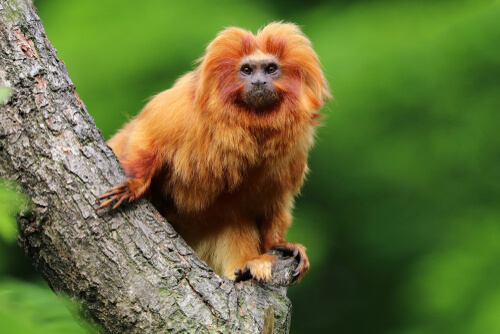
| Kingdom | Animalia |
| Phylum | Chordata |
| Class | Mammalia |
| Order | Primates |
| Family | Callitrichidae |
| Genus | Saguinus |
| Species | Saguinus ursula, 12 others |
| Niche | Omnivorous Primate |
| Length | 5.1-11.8 in (13-30 cm) |
| Weight | 7.8-31.7 oz (220-900 g) |
| Lifespan | 10-18 years |
| Social Structure | Family groups |
| Conservation Status | Endangered |
| Preferred Habitat | Forest canopy |
| Average Litter Size | 2 |
| Main Prey Species | Insects, small birds, and lizards, fruits |
| Predators | Snakes, wild cats, birds of prey |
The Basics
The tamarin is a small monkey of the genus Saguinus native to the New World. There are 13 members of the genus and they live in the treetops in the jungles of the Amazon basin and other parts of Central and South America. Along with their jungle habitat, most species are endangered.
Appearance
The golden lion tamarin (S. ursula) is one of the most notorious species of tamarin. It has an impressive golden-brown mane of fur reminiscent of those of male lions. This frames its small, black, face, and relatively long tail. Other species are black and some have interesting mustache-like features. Of the 13 species currently recognized in the genus, they range in weight from 7.8-31.7 oz (220-900 g) and 5.1-11.8 in (13-30 cm) in length, not including their tails.
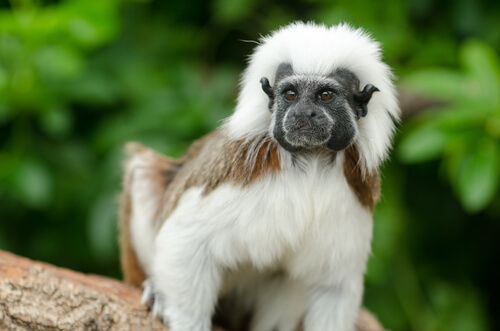
Diet and Predators
Tamarins are arboreal, living in trees within their range in tropical rainforests. At night, they will rest in tree hollows here. During the day, they leap and climb from branch to branch, foraging for food. They will use their long fingers to snag insects, fruit, and small lizards and birds.
Tamarins are small primates and themselves are subject to predation by a variety of animals. Snakes will prey on them and their young. Also, wild cats and various species of birds of prey will also feed on tamarin when possible. They typically rely on their speed and ability to move swiftly in the forest canopy to avoid predation. They will also hide in tree hollows at night to avoid detection by predators.
Social Structure and Breeding
Tamarins are social and form family groups of up to 40 individuals. However, a typical family group may be closer to about 10 individuals. Within this, males are involved in raising their offspring and will even carry them around between feedings.
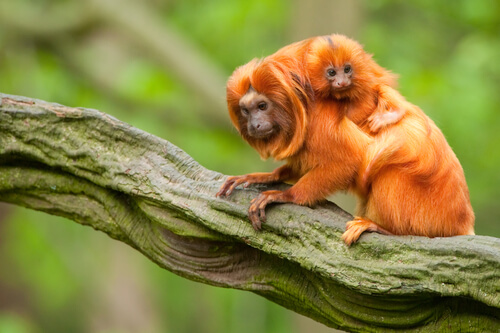
Following copulation, females normally experience a gestation period of about 140 days. Females typically give birth to two young at a time, usually twins. Males and other juveniles in the family will assist in raising the new monkeys, often caring for them throughout the day but returning them to their mothers to nurse as required. At about one month, new tamarin will begin to eat solid food. However, they are not entirely weaned from their mothers until about 3-4 months of age. By their second year, they will reach full maturity and become an independent member of the family. Tamarin can live to about 18 years in captivity, although individuals of most species likely live closer to about 10 years.
Conservation Status
Tamarins live largely in the Amazon rainforest basin – one of the most biodiverse areas in the world. It is also one of the most threatened areas in the world. Deforestation due to logging and agriculture continue to strip the tamarin and hundreds of thousands of other species of their natural habitats. The golden lion tamarin is currently listed as Endangered on the IUCN Red List, which is an improvement from its previous Critically Endangered status.
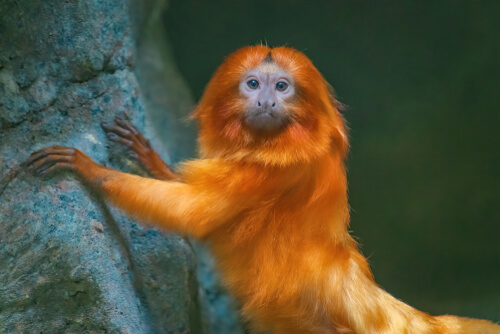
Fun Facts about Tamarin!
Tamarins live in an exceedingly rare and highly important part of the world. With so many closely related species in such a relatively small and productive area, the tamarin is an excellent primate to learn more about.
Difficult to Categorize
Tamarin taxonomic is not straight forward. Originally, the genus Saguinus contained ten species that themselves were divided into further ‘morphotypes’ based on their unique facial hair patterns. Later, dental measurements were used to separate these into two ‘clades’ and eventually into 15 species within the genera and no subspecies.
In 2016, researchers conducted genetic analyses on the genus and other primates. This suggested that some of the current members of the genus, such as the saddle-back tamarin (Leontocebus spp.) had diverged from other members some 10 million years ago, which is earlier than other monkeys and marmosets of genera such as Callithrix, Cebuella, and Mico. Therefore, the saddle-back tamarin was moved from Saguinus to Leontocebus, leaving the former with 13 current member species.
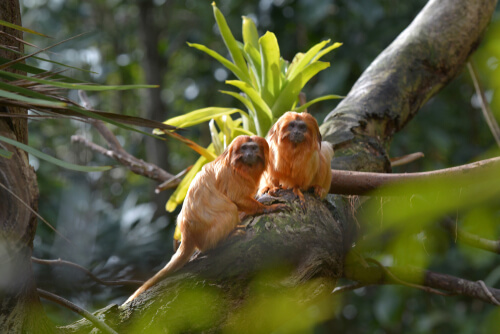
The Golden Touch
The red-handed tamarin (Saguinus midas) has evolved an interesting and beautiful color morph. Native to the wooded areas north of the Amazon river, this species is known for the conspicuous golden hair on its hands which stands in contrast to its mostly black fur. It also has some gold-colored flecking on its anterior side and rump
Fierce Competition
With the native range of all tamarin species being threatened and global climate change altering weather patterns in many areas, some tamarin species are relocating. This causes ripple effects on the ecosystem, and can even add to the demise of other tamarin species as competition for remaining habitat becomes fierce. Interspecific competition between the red-handed marmoset, which is expanding into the historical range of the pied tamarin (Saguinus bicolor), is leading to the latter’s replacement by the former. This further highlights the challenges associated with conservation efforts which, at times, may aim to introduce a threatened species to a new range to save it, only harming other species there.
